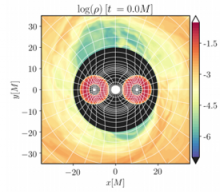
Abstract
We perform a full 3D general relativistic magnetohydrodynamical (GRMHD) simulation of an equal-mass, spinning, binary black hole approaching merger, surrounded by a circumbinary disk and with a mini-disk around each black hole. For this purpose, we evolve the ideal GRMHD equations on top of an approximated spacetime for the binary that is valid in every position of space, including the black hole horizons, during the inspiral regime. We use relaxed initial data for the circumbinary disk from a previous long-term simulation, where the accretion is dominated by a m=1 overdensity called the lump. We compare our new spinning simulation with a previous non-spinning run, studying how spin influences the mini-disk properties. We analyze the accretion from the inner edge of the lump to the black hole, focusing on the angular momentum budget of the fluid around the mini-disks. We find that mini-disks in the spinning case have more mass over a cycle than the non-spinning case. However, in both cases, we find most of the mass received by the black holes is delivered by the direct plunging of material from the lump. We also analyze the morphology and variability of the electromagnetic fluxes and we find they share the same periodicities of the accretion rate. In the spinning case, we find that the outflows are 8 times stronger than the non-spinning case. Our results will be useful to understand and produce realistic synthetic light curves and spectra, which can be used in future observations.